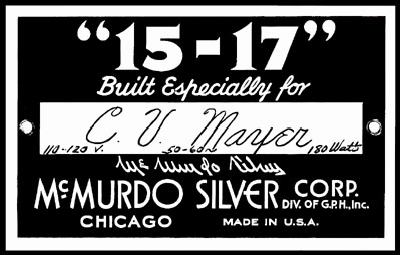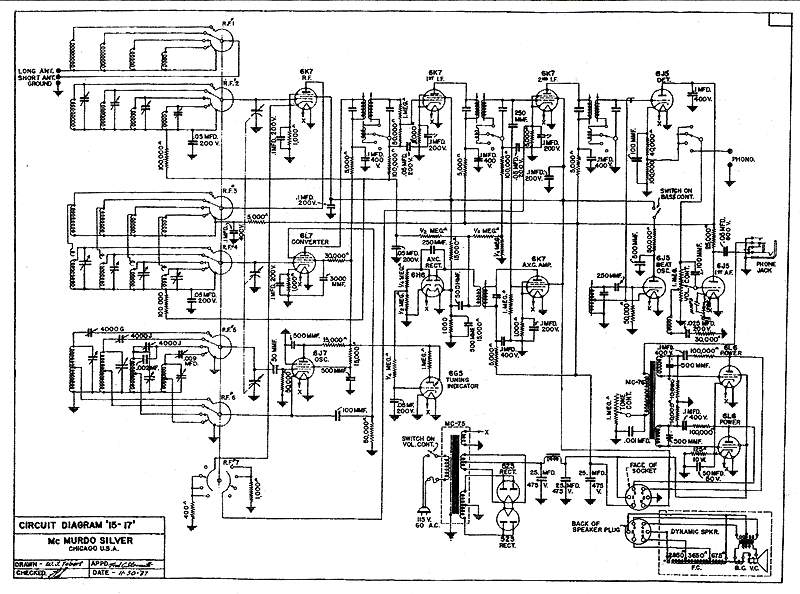|
Radio News and Shortwave Radio
February 1938
Pages 460 & 510
A New Receiver With 15 Tubes Fuctioning as 17
(McMurdo Silver All-Wave "15-17")
By McMurdo Silver
Those who have owned and operated superheterodynes of the 1931-
32 vintage, practically all of which employed a low
intermediate-frequency, of approximately 175 kc., will remember that
they were so excessively sharp in tuning that they seriously impaired
tone quality. When the all-wave receiver began to replace the older
broadcast-band receivers, extreme selectivity became hard to attain,
because a high i.f. had to be used for short-wave reception in order to
avoid image interference. The result is that the average radio receiver
today will actually separate stations spaced 10 kc. apart only under
most favorable conditions.
The new "15-17" all-wave receiver herein described
provides not only selectivity actually better than that of the older 175
kc, i.f. amplifier receivers, but variable selectivity as well. It
tunes continuously from 565 to 9.4 meters, a total frequency range of
530 to 32,000 kc. This range is covered using quite low values of gang
tuning condenser in order to provide the high L/C tuning ratios
necessary to maximum r.f. amplification. Its fifteen tubes are used in
the circuit of Figure 1. One 6K7 is a stabilized-regenerative tuned r.f.
amplifier. Following are a 6L7 noiseless first detector; 6J7 electron
coupled, voltage and temperature stabilized oscillator; two 6K7 i.f.
amplifiers in the new "Tri-Band" i.f. amplifier; 6K7 tuned a.v.c.
amplifier and 6H6
a.v.c. rectifier; 6J5 infinite impedance second detector; 6J5 audio-beat
oscillator; 6J5 tuned-audio driver stage; two 6L6 beam-power tubes in
the 20-watt power output amplifier and two 5Z3 rectifiers. A new 15-inch
Jensen-Silver speaker and the super-fine audio system of the famous
Masterpiece V and Masterpiece VI give the "15-17" really superb tone.
A total of twelve r.f. transformers, in four groups of
three, cover the tuning ranges of 530 to 1650 l.c., 1600 to 5500 kc.,
5300 to 12,500 kc. and 12,000 to 32,000 kc. The tuned r.f. transformer
coupling the 6K7 r.f. amplifier to the 6L7 first detector presents to
the 6K7 plate circuit the high impedance necessary to obtain the
stabilized-regenerative amplification which must increase with signal
frequency if it is to equalize gain and selectivity throughout the range
of 530 to 32,000 kc. Measurement indicates that at 13 meters as much
gain is had as in the 200 to 550 meter band.
High "Q" Coils
There is nothing new about the first detector and
oscillator; they are the same circuits as in the Masterpiece V and VI.
It is in the 472 kc. "Tri-Band" i.f. amplifier that most of the
selectivity of the "15-17" is obtained. This is accomplished through use
of new Litz coils (measuring Q205) wound upon a newly developed
high-permeability powdered r.f. iron core. Six such coils in the three
dual tuned transformers gave several times more amplification than could
possibly be used. At the considerably lower level actually desired,
stability was accompanied with complete freedom from noise. This 2-stage
amplifier gave a selectivity curve 3 kc. broad on its
intelligence-carrying "nose", falling off steeply to a total width of
only 15 kc. at 10,000 times resonant input. At 20 kc. band width the
measure of rejection for unwanted stations but 10 kc. away from a
desired station was 30,000 times; for stations only 5 kc. away from
resonance, rejection was 1,000 times. For broadcast and amateur DX
telephone reception this is everything that can ever be asked.
Variable Selectivity
Tone, with such selectivity cannot provide high quality
musical reproduction. Selectivity is therefore made variable through
permanently fixed i.f. couplings. By this means, a simple turn of the
"selectivity" knob gives instantaneous choice of 3 kc., 8 kc., or 16 kc.
selectivity, besides shifting the audio amplifier input to terminals
for pick-up connection for phonograph reproduction. Here is every
selectivity choice needed for all modern reception conditions
instantaneously available at the turn of the knob. I.F. circuit
alignment is effected through inductance variation, the tuning
capacities being fixed. Micrometric movement of the powdered iron cores
of the i.f. coils does the trick permanently, in spite of heat, cold,
damp, dry and vibration.
The 6J5 infinite-impedance, linear second detector not
only eliminates the harmonic distortion introduced on high-percentage
modulation by diode detectors, but it places a high-resistance load
across the last i.f, transformer and so makes an important selectivity
contribution. Coupled to it for optimum weak-signal strength is the 6J5
audio-beat oscillator the beatnote pitch is adjustable from the chassis
rear. So selective is the entire receiver that by tuning the beat
oscillator to produce a 1500 to 2,000 cycle audio-beat note good
"single-signal" c.w. code reception is obtained.
The amplified a.v.c. system is operated from the first
i.f. tube in order that the a.v.c. amplifier itself may be made
sufficiently broad in tuning to follow approximate r.f. selectivity
curve shape. This results in a system which holds received signals,
varying through the range of 20 to over 1,000,000 microvolts input, at
volume constant to 3 db.
The audio amplifier uses a 6J5 triode driver tube in
conjunction with a Clough system tuned push-pull audio transformer which
is tuned by the "bass tone" knob to give anything from bass "boost" of
16 db., to a 30 db. bass "droop." This plus treble tone control provides
the comp cle control of tone so necessary to compensate for different
programs, individual taste in tone, and variations in individual home
acoustics.
Two 6L6 beam power tubes, operated Class AB1 in a
10-percent -cc(]back circuit develop 16 watts power output strictly
Class A, and a maximum of 20 watts at less than 3 % total harmonic
distortion for the entire audio amplifier. The new 15-inch loudspeaker
will actually reproduce down to 30 cycles, up to 8.000 cycles, and is
about 2/ times more efficient than ordinary 10-inch and 12-inch
speakers. But even this speaker cannot reproduce actual sound much below
130 cycles in an ordinary console cabinet. So consoles are provided
which incorporate the new Jensen invented "peri-dynamic" and
"basereflex" principles, allowing the speaker to preproduce tones down
to 30 cycles. What more can be asked than 3, S and 16 kc. selectivity,
sensitivity of to 1 microvolt on all bands, complete coverage of 530 to
32,000 kc., signal-to-noise-ratio of better than 3: 1 at / microvolt
sensitivity, a.v.c. action holding practically all stations at constant
volume, not over 3 percent total harmonic distortion, up to 20 watts
power output, tone so variable as to be "all things to all men,"
provision for phonograph and headphone operation, 60 to over 200 degrees
of bandspread (2/ to 9 inches of band spread dial length on the
principal short-wave bands) and automatic 16:1 and 80:1 tuning knob
ratios?
|
|




